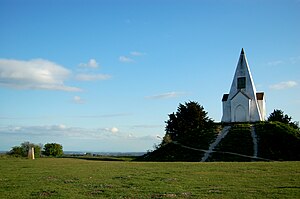Farley Mount
| Farley Mount | |||
| Hampshire | |||
|---|---|---|---|

| |||
| Range: | Hampshire Downs | ||
| Summit: | 571 feet SU403290 51°3’33"N, 1°25’34"W | ||
Farley Mount is a hill in Hampshire, located amongst the Hampshire Downs. It is foiund within Farley Mount Country Park, situated about four miles west of the county town – the historic city of Winchester.
This hill is locally famous for being the subject of a folk song, 'On Farley Mount'. It featured the lines:
"oh on Farley Mount the clouds drift by,
rustling the trees, on Farley mount I wonder why,
what troubles you and I,
blue is the sky and so are your eyes,
oh left alone on Farley Mount."
It is believed to date back to at least the sixteenth century and is still sung in pubs in the area.
| Farley Mount | |||
| Hampshire | |||
|---|---|---|---|

| |||
| Range: | Hampshire Downs | ||
| Summit: | 571 feet SU403290 51°3’33"N, 1°25’34"W | ||
Farley Mount is a hill in Hampshire, located amongst the Hampshire Downs. It is foiund within Farley Mount Country Park, situated about four miles west of the county town – the historic city of Winchester.
This hill is locally famous for being the subject of a folk song, 'On Farley Mount'. It featured the lines:
"oh on Farley Mount the clouds drift by,
rustling the trees, on Farley mount I wonder why,
what troubles you and I,
blue is the sky and so are your eyes,
oh left alone on Farley Mount".
It is believed to date back to at least the sixteenth century and is still sung in pubs in the area.
Monument
On top of the mount is a folly, which stands as a monument and burial place marker to a horse named 'Beware Chalk Pit', which carried its owner to a racing victory in 1734, a year after falling into a twenty-five feet deep chalk pit while out hunting.[1][2]

The monument is the subject of Timothy Corsellis' poem 'the first great goodbye'. Corsellis, an alumnus of Winchester college who lived in the early-mid 20th century, wrote:
'I'll plant myself on Cheesefoot Head
and miles of Hampshire will I tread,
I'll turn my nose to Farley Mount
No ugly bypass need I count,
And in a second I'll be there
Or in the beech woods standing near'.
Goethals, Helen, ed (4 Jan 2013). The Unassuming Sky: The Life and Poetry of Timothy Corsellis. Winchester, UK: Cambridge Scholars. ISBN 1443845175.
There are plaques on the interior and exterior of the monument, which read:
- Underneath lies buried a horse, the property of Paulet St. John Esq., that in the month of September 1733 leaped into a chalk pit twenty-five feet deep afoxhuntiing with his master on his back and in October 1734 he won the Hunters Plate on Worthy Downs and was rode by his owner and was entered in the name of "Beware Chalk Pit".[1]
The folk band Contraband recorded "Beware Chalk Pit" by Graham Penny, featuring the words: There's a tale I'll tell to you, tis remarkable but true, of Sir Paulet St. John and his noble steed, an event as you shall see, back in seventeen thirty three, of which Hampshire gentlemen should all take heed. CHORUS: Beware Chalk Pit, Beware Chalk Pit, as you go galloping o'er the downs, Beware Chalk Pit.[3]
References
- ↑ Jump up to: 1.0 1.1 "The Horse Monument at Farley Mount". Hampshire County Council. http://www3.hants.gov.uk/countryside/fmcp/monument.htm. Retrieved 2010-02-04.
- ↑ Nikolaus Pevsner: The Buildings of England: Hampshire & The Isle of Wight, 1967 Penguin Books ISBN 978-0-300-09606-4page 278
- ↑ "Beware Chalk Pit discussion". mudcat.org. http://mudcat.org/thread.cfm?threadid=152581&messages=16. Retrieved 2017-02-05.